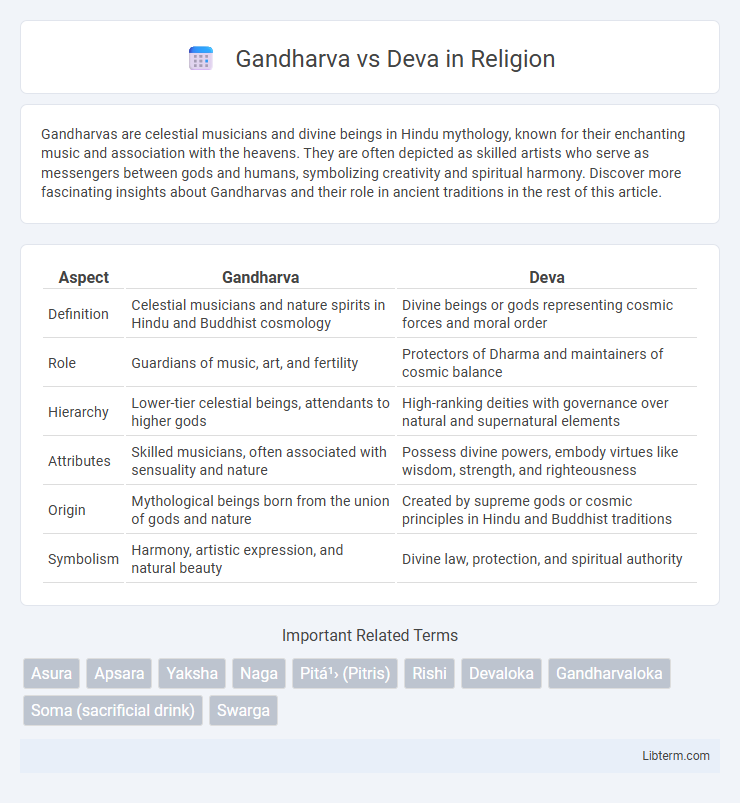Gandharvas are celestial musicians and divine beings in Hindu mythology, known for their enchanting music and association with the heavens. They are often depicted as skilled artists who serve as messengers between gods and humans, symbolizing creativity and spiritual harmony. Discover more fascinating insights about Gandharvas and their role in ancient traditions in the rest of this article.
Table of Comparison
| Aspect | Gandharva | Deva |
|---|---|---|
| Definition | Celestial musicians and nature spirits in Hindu and Buddhist cosmology | Divine beings or gods representing cosmic forces and moral order |
| Role | Guardians of music, art, and fertility | Protectors of Dharma and maintainers of cosmic balance |
| Hierarchy | Lower-tier celestial beings, attendants to higher gods | High-ranking deities with governance over natural and supernatural elements |
| Attributes | Skilled musicians, often associated with sensuality and nature | Possess divine powers, embody virtues like wisdom, strength, and righteousness |
| Origin | Mythological beings born from the union of gods and nature | Created by supreme gods or cosmic principles in Hindu and Buddhist traditions |
| Symbolism | Harmony, artistic expression, and natural beauty | Divine law, protection, and spiritual authority |
Introduction to Gandharva and Deva
Gandharvas are celestial musicians and singers in Hindu mythology, known for their enchanting music and role as divine messengers between gods and humans. Devas, on the other hand, are powerful gods who govern natural forces and uphold cosmic order, often depicted as protectors and rulers of various aspects of the universe. While Gandharvas emphasize artistic expression and communication, Devas embody authority and divine governance in the celestial hierarchy.
Origins and Mythological Background
Gandharvas are celestial musicians in Hindu mythology, often depicted as attendants of Indra, originating from the union of sages or divine beings embodying artistic and musical talents. Devas, on the other hand, are a broader category of gods representing various natural forces and cosmic principles, emerging from primal entities like Prajapati or the cosmic egg in Vedic cosmogony. The Gandharvas serve a specialized role within the divine hierarchy, whereas Devas encompass a wide pantheon of deities responsible for maintaining cosmic order.
Key Characteristics of Gandharvas
Gandharvas are celestial musicians and singers known for their mastery of music and enchanting melodies, often associated with the natural world and forest realms. They serve as intermediaries between gods and humans, possessing supernatural abilities like shape-shifting and telepathy, distinguishing them from Devas who are primarily divine gods embodying cosmic order and governance. Gandharvas' key characteristics include their role as celestial entertainers, expert musical skills, and guardians of sacred rituals, emphasizing their cultural significance beyond Devas' more authoritative and divine administrative roles.
Defining Traits of Devas
Devas embody divine qualities such as benevolence, wisdom, and cosmic authority, often depicted as celestial beings governing natural and moral order. Their defining traits include immortality, immense power, and roles as protectors of dharma within Hindu cosmology. Unlike Gandharvas, who are skilled musicians and attendants of the gods, Devas exercise broader control over cosmic functions and spiritual realms.
Roles and Responsibilities in Hindu Cosmology
Gandharvas serve as divine musicians and celestial messengers, responsible for enchanting gods and humans with their music and facilitating communication between realms. Devas hold the role of powerful gods governing natural forces, cosmic order, and dharma, ensuring balance and protection in the universe. While Gandharvas primarily support through artistic and communicative functions, Devas undertake broader cosmic administration and guardianship in Hindu cosmology.
Gandharvas vs Devas: Major Differences
Gandharvas are celestial musicians known for their association with music, arts, and enchantment, while Devas represent powerful gods governing natural forces and cosmic order. Gandharvas primarily function as attendants to higher deities and embody creativity and cultural expression, contrasting with Devas who exercise authority over elements like weather, justice, and fate. This distinction highlights Gandharvas' role in inspiring artistic endeavors, whereas Devas uphold universal law and divine administration.
Depictions in Ancient Texts and Scriptures
Gandharvas and Devas are distinct celestial beings frequently depicted in ancient Hindu texts such as the Vedas and Puranas, where Gandharvas are portrayed as heavenly musicians and guardians of Soma, emblematic of artistic inspiration and sensual pleasure. Devas, epitomized in scriptures like the Rigveda and Mahabharata, are revered as powerful divine forces overseeing cosmic order, natural phenomena, and moral law, often depicted wielding weapons and seated on radiant thrones. The symbolic representation in scriptures highlights Gandharvas as ethereal entertainers linked to nature's creative aspects, contrasting with Devas' exalted status as supreme protectors and enforcers of dharma.
Relationship and Interactions between Gandharvas and Devas
Gandharvas and Devas share a symbiotic relationship in Hindu mythology, where Gandharvas serve as celestial musicians and messengers in the divine courts of the Devas. Their interactions often involve collaborative participation in cosmic events and rituals, with Gandharvas enhancing the Devas' celebrations through music and dance. This dynamic highlights the complementary roles each group plays in maintaining cosmic order and spiritual harmony.
Cultural Significance and Worship
Gandharvas hold significant cultural roles as celestial musicians and messengers in Hindu and Buddhist traditions, often associated with divine music and artistic inspiration, while Devas represent principal gods governing natural elements and cosmic order. Worship of Gandharvas typically involves rituals emphasizing music, dance, and artistic offerings, highlighting their role in spiritual elevation and cultural festivals. Deva worship is more elaborate and widespread, encompassing temple rituals, prayers, and festivals dedicated to maintaining cosmic harmony and receiving divine blessings for prosperity.
Conclusion: Impact on Modern Hindu Understanding
The distinctions between Gandharvas and Devas shape contemporary Hindu cosmology by emphasizing diverse divine roles, with Gandharvas often seen as celestial musicians embodying artistic inspiration, while Devas represent higher-tier gods governing natural forces and moral order. This differentiation deepens the understanding of Hindu pantheon complexity, reflecting a layered spiritual hierarchy that influences ritual practices and theological interpretations today. Modern Hinduism integrates these entities to highlight the balance between creative expression and divine governance in the cosmic order.
Gandharva Infographic

 libterm.com
libterm.com